Read more about wildflowers that you will encounter at Suncadia!
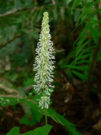
Vanilla Leaf- Achlys triphylla is an attractive perennial with single, long-petiolate, ternate (3 leaflets) leaves which are fan-shaped with coarsely-toothed leaf edges. The leaf blade is roughly 5-20 cm wide, with the whole leaf ranging from 10-30 cm long. Dry leaves smell of vanilla.
The flower stem is separate from the leaf and ranges from 20-40 cm tall. The apex of the stem has a dense spike (2.5-5 cm long) of tiny white flowers with no petals nor sepals.
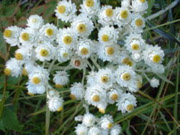
Pearly Everlasting-Anaphalis margaritacea
Individual erect cottony stems grow 1-3 ft. tall and are often clumped together creating a bushy appearance. Narrow leaves are gray-green to woolly-white. Globular flowers are actually long-enduring white dry bracts arranged around a yellow center. Several evenly leafy woolly stems in a small patch are topped by a crowded roundish cluster of flower heads with pearly-white bracts sometimes with a dark spot at the base of each outer bracts.
The dried stalks with their pearly-white heads are attractive in floral arrangements. The pure white flower is commonly used in dried flower arrangements.
Good dried flowers; food plant for Painted lady butterflies.
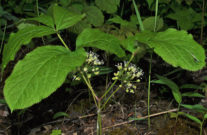
Wild Sarsaparilla-Aralia nudicaulis It has a stout, flexuous and square stem, with a few hooked prickles above. Leaves unarmed, elliptical-ovate, cuspidate, abruptly contracted at each end; three strong veins, two lateral smaller secondary ones; underside glaucous, 3 inches diameter, on short margined petioles, with two long tendrils at their bases. Flowers yellowish-white, appearing May to August, in small thin umbels of three or four red or black berries, three-seeded.

Heartleaf Arnica- Arnica cordifolia is deciduous perennial arising to a height of 10-60 cm from naked rhizomes. The stems are solitary, or occasionally several loosely clustered together. The stems are covered with minute glandular hairs, or loosely with white hairs (see photos). The 2-3 pairs of opposite, heart-shaped stem leaves. range from 4-12 cm long and 3-9 cm wide. The leaf margins are usually coarsely toothed, but may also be entire.
The flowers are found at the tips of the stems and are usually solitary, although it is possible that several could be clustered together. The flower heads have a yellow central disk surrounded by 10-15 yellow ray flowers. The tips of these ray flowers are pointed. Individual rays are 1.5-3 cm long. The involucre is 13-20 mm tall and sparsely to thickly covered with long white, spreading hairs.
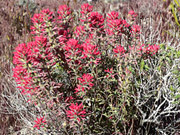
Indian Paintbrush-Castilleja spp.
The leaves of the Indian Paintbrush are long and narrow pointed but without teeth. The upper leaves can have 3 lobes and fine hairs. Indian Paintbrush flowers are set in clusters are long, tube-like; pale green to red on the ends and partly hidden by brilliant red, hairy and toothed bracts. Indian Paintbrush grows in mid to high elevations in dry to moist areas such as forests, roadsides, and slopes.
Indian paintbrush is a member of the figwort family. This perennial, that has a cluster of stems that grow upward from the base, can grow up to 60 cm. tall.
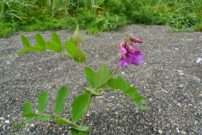
Pea Vine-Lathyrus spp.
Peavine is a fairly attractive perennial wildflower with several stems arising from rhizomes and erect or clambering through the foliage to lengths of 15-80 cm. The stems are angled but not winged and the stem and leaves are sparse to fairly densely covered with soft hairs, especially on the calyces and undersides of the leaves. The leaves alternate along the stems and are pinnately compound. Individual leaves have 8-14 leaflets that are either paired or scattered. The leaflets are linear, ovate-lanceolate or lanceolate-elliptic in outline and measure from 2-12 cm long and 2-30 mm wide. The tendrils range from reduced and bristle-like to fairly well developed (in variety pilosellus) and are found at the tips of the leaves. The stipules are generally less than half as long as the leaflets and linear-lanceolate to lanceolate in outline and 2-lobed.
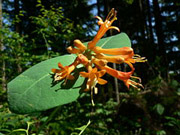
West Trumpet Honeysuckle-Lonicera ciliosa
The trumpet honeysuckle is generally described as a Perennial Vine. This Dicot (dicotyledon) is native to the U.S. (United States) and has its most active growth period in the Spring. The Trumpet Honeysuckle has Green foliage and conspicuous Red flowers, with conspicuous Black fruits or seeds. The greatest bloom is usually observed in the Late Summer, with fruit and seed production starting in the summer and continuing until fall. Leaves are retained year to year. The Trumpet Honeysuckle has a Long life span relative to most other plant species and a Rapid growth rate. At maturity, the typical Trumpet Honeysuckle will reach up to 16.4 feet high, with a maximum height at 20 years of 16.4 feet.
The Trumpet Honeysuckle is not commonly available from nurseries, garden stores, and other plant dealers and distributors. It can be propagated by Bare Root, Container and Seed. It has a slow ability to spread through seed production and the seedlings have Medium vigor. Note that cold stratification is not required for seed germination and the plant cannot survive exposure to temperatures below -33°F. Trumpet Honeysuckle has Low tolerance to drought and restricted water conditions.
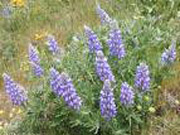
Broadleaf Lupine-Lupinus latifolius
Broad-leaf lupine is an attractive perennial with erect stems up to 1 meter in height, varying with variety from sparsely haired to heavily haired. The stems typically have 6-8 leaves with the lower leaves having petioles 2-3 times longer than the blade. The lower leaves tend to persist through flowering time. The petioles of the upper leaves range from 1-2 times longer than the blades. The 7-9 leaflets are elliptic to obovate in shape and each ranges from 3-6 cm long and 10-20 mm wide. The upper leaf surface tends to be less haired than the lower surface.
The inflorescence consists of several showy racemes from 10-20 cm long. The thin flower pedicels range from 4-9 mm long. The flowers range from light blue to bluish or lavender or may be marked with bright violet. The flowers range from 12-15 mm long. The back of the banner lacks hairs and is distinctly well reflexed backward from the wings and keel (Index = 15-30.) The wings lack hairs and completely cover the curved keel. The calyx is silky to shaggy-haired and lacks a spur or sac. The upper calyx lip is shallowly double-toothed. The seed pods range from 2-3 cm long and average 8 mm wide.

Spurred Lupine – Lupinus laxiflorus
Spurred lupine is an attractive perennial wildflower suitable for mountain or arid climates. Its numerous stems are spreading to erect and are simple to sparingly branched, ranging from 20-80 cm high. The herbage consists of fine, appressed hairs that all point in one direction and which give the stems and leaves greenish-gray to silver-gray appearance. The palmately compound leaves are primarily found on the stems. The petioles of the lower leaves range from 2-4 times longer than the leaf blades, while the upper petioles are roughly half as long as the blades. The blades consist of 7-11 narrowly oblong-oblanceolate to oblong leaflets with the tips ranging from pointed to occasionally obtuse or rounded. The leaflets range from 3-5 cm long. The herbage of the leaves is various ranging from pubescent on both surfaces to glabrous above and silvery-haired below.
The racemes are 7-20 cm long and range from loosely flowered to sometimes fairly crowded. The flowers range from 9-14 mm long with flower stems from 3-7 mm long. The calyx has a noticeable sac or spurs just above its attachment point to the flower stem. The spur ranges from 1-3 mm long. The upper lobe of the calyx is cleft at its tip and is usually less than 1/3 the length of the corolla wings. The banner is fairly pubescent on its back to above the center. The wings are minutely hairy on the upper side, just below the banner. The margin of the keel is fringed by minute hairs most of its length. The flowers vary from blue, pink, violet, rose and purple to cream or white. The pods are fairly covered with silky hairs and range from 2-3.5 cm long.

Sweetroot Sweet-cicely-Osmorhiza chilensis
Sweetroot Sweet0cicely is a wispy, very delicate plant easily over-looked even though they are common. They grow singly, as in this picture, or in large colonies lining trails. Tiny white flowers are grouped in equally tiny sprays. These give way to long, cylindrical seed pods. Stems, leaves, seeds, and especially roots of Sweet Cicely often have a pleasant anise flavor and aroma, thus its Greek genus name: “osmo” for “smell” and “rhiza” for “root”. “Chilensis” is for the country of Chile where the plant was first collected in the late 1820s. “Depauperata”, “diminutive”, perhaps refers to Sweet Cicely’s very delicate, fragile form and tiny flowers.
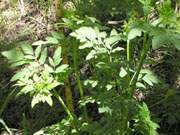
Western Sweet – Cicely-Osmorhiza occidentalis
The Osmorhiza occidentalis flower is so tiny and so spread on long stems that it is easily overlooked. Leaves are pointed and serrated; stems are thick and swaying. Osmorhiza occidentalis can occur singly in open dry woods or in very large patches in moist woods. Compare this Sweet Cicely to its even more common close relatives, Osmorhiza depauperata and Osmorhiza chilensis above.
Stems, leaves, seeds, and roots of Sweet Cicely often have a pleasant anise flavor and aroma, thus its Greek genus name: “osmo” for “smell” and “rhiza” for “root”. “Occidentalis” is Latin for “Western”.
Thomas Nuttall collected the first specimen of this plant in what is now Oregon in the early 1830s. He named it Glycosma occidentalis in 1840 and it was given its present name by John Torrey in 1858.
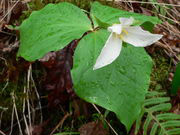
White Trillium- Trillium ovatum
Trillium ovatum is our native trillium, also known as the ‘wake-robin’ trillium. Once widespread throughout lowland western Washington, the habitat has shrunk as more and more development occurs. Very tough and reliable, one knows that spring is here when this trillium comes into flower. Summer drought tolerant (when established), this plant will work well in almost any garden that can offer a partly shaded environment. We have multiple plants here in the garden, both plants that Ed planted and new ones are grown from seed by a local grower.